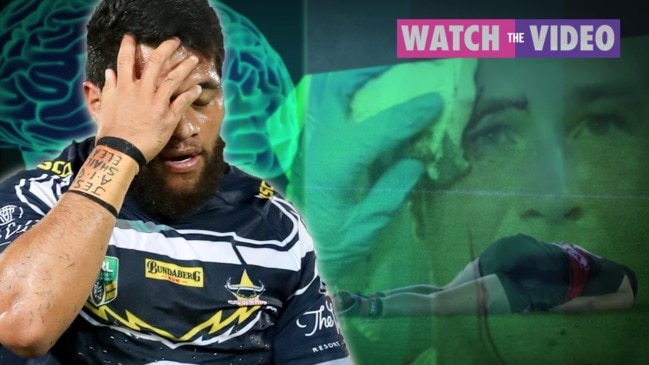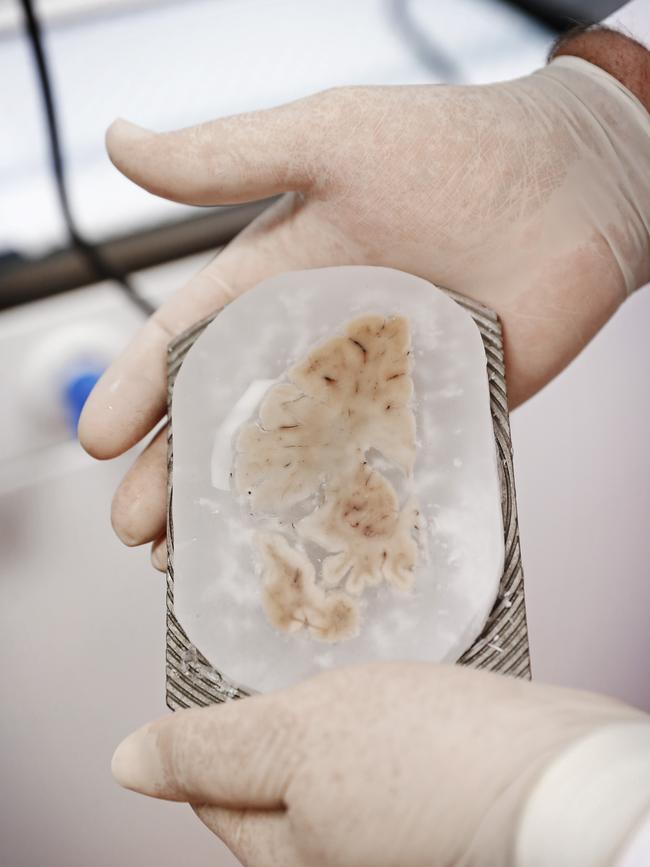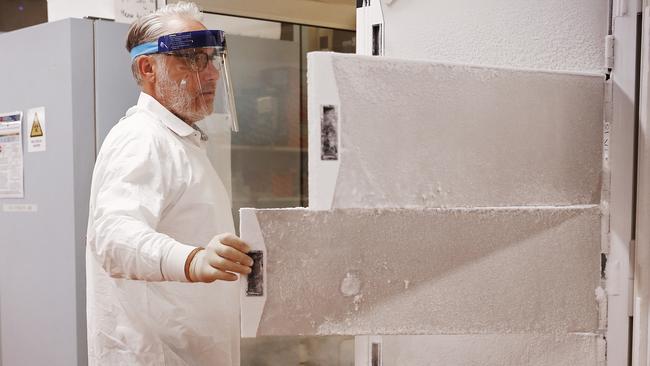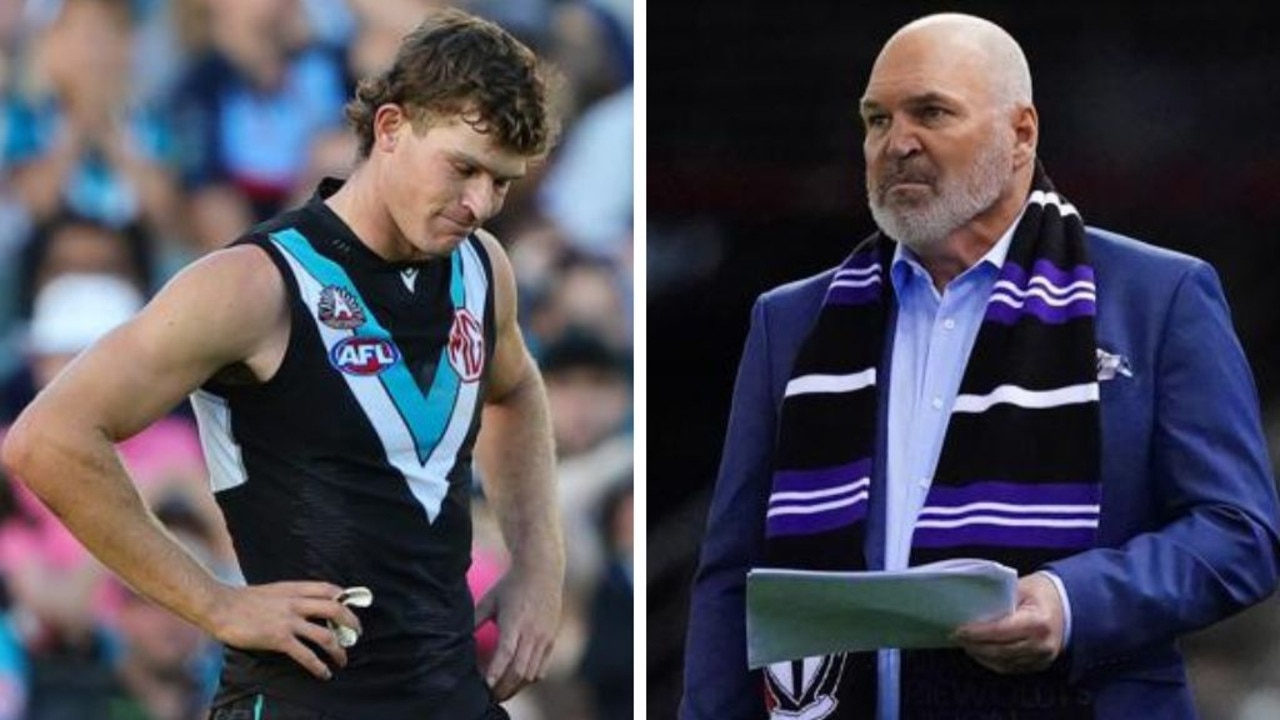Brain Bank professor believes blood tests will be able to diagnose CTE in living people by 2031
It is the stunning prediction that could change thousands of lives, including sports people across the world. Find out what is happening inside the Brain Bank.

Sport
Don't miss out on the headlines from Sport. Followed categories will be added to My News.
Blood tests will be able to diagnose chronic traumatic encephalopathy in a living person by 2031, Professor Michael Buckland from Sydney’s Brain Bank believes.
The groundbreaking prediction would change thousands of lives, from footballers to military personnel and others dealing with repetitive head trauma that leads to CTE as it can only be diagnosed in the deceased.
Prof Buckland is Australia’s leading CTE analyst and has discovered the condition in former NRL player Steve Folkes and ex-AFL players including Danny Frawley, Shane Tuck and Graham “Polly” Farmer at Sydney’s Brain Bank, where 20 other brains are stored for study.
Because CTE can only be diagnosed by cutting open the brain, doctors cannot definitively say whether early onset dementia, depression and other issues linked to CTE are a result of head trauma — and are therefore restricted in treatment options.
But Prof Buckland is confident that scientific breakthroughs can revolutionise how we manage CTE within the next decade.

“I think it’ll happen in my professional career, so I would imagine in the next 10 years we’ll have at least pretty good ways to diagnose it,” Prof Buckland said.
“We hope to be able to contribute to that ourselves with our own research. By looking at the brains of people that have CTE and looking at what’s different, what protein molecule is different, what molecular marker is different, you can find what’s unique about those lesions. We plan to be looking in the blood for those markers.
“At the moment, as CTE can only be diagnosed after death by examination of the brain at autopsy, the way we gather data about how that person was during life is, by necessity, a retrospective analysis. So that is talking to family members and reviewing medical records.
“What that means is that it’s a complicated task and quite labour-intensive.


“I’m hopeful that there will be a time in the future where we will be able to have either a specialised brain scan or a blood test or electrophysiological test that will be able to tell us during life that someone has CTE.
“Once we’re able to diagnose it during life then we’ll be able to trial treatments and measure their effects on that person and on that objective biomarker, whatever it is, blood test, whatever.
“So a diagnosis during life will open the door to clinical trials and advancement in our understanding of how to treat it.”
Other researchers in Australia and around the world have suggested spinal fluid and saliva tests may help detect CTE in the living in future.
“My feeling is it would be a combination of tests; a thorough neurological examination followed by specific neuropsychological tests added on to a blood test or tests of the cerebrospinal fluid, as well as an advance scan of the brain,” he said.
“I think that that is the most likely way in the future. We will make that diagnosis during my life.”


The clumped tau protein in the brain, a key indicator of CTE and cause of Alzheimer’s disease, can be caused by repetitive sub-concussive hits to the head.
Prof Buckland’s work at the Brain Bank has been crucial to our understanding of CTE, and while hundreds of footballers have pledged to have their brains analysed by the Brain Bank after they die, he is urging donations from all walks of life to gain a true picture of this condition.
“We have over 350 pledges now, which is fantastic, it certainly exceeded what I thought would happen, we’re only three years into it since we launched the Brain Bank,” he said.
“Ideally, I’d like to see over a thousand in the coming 12 months. Whether or not we can achieve that, we’ll wait and see.


“I think it’s important that people realise that we’re not just interested in professional sports people, we’re interested in people signing up that have had all levels of exposure to contact sports, including no level of exposure.
“It’s when we get that broad range of different types of sports, males and females, different levels of exposure, whether you just played it in high school, or college, that’s fine as well.
“There are other sports where repetitive head injury is not such an issue, such as golf, and we need those sort of people to donate their brains as well.
“We want to look at a broad range of people with a broad range of exposure, and that’s how we’re going to sort of drill into the detail of how common this disease is and what are the exact risk factors.”
HOW TO RECOGNISE CONCUSSION
Head impacts can be associated with serious and potentially fatal brain injuries. The Concussion Recognition Tool 5 (CRT5) — an international document created by the Concussion in Sport Group for sporting codes around the world — is used for the identification of suspected concussion. It is not designed to diagnose concussion.
STEP 1: RED FLAGS — CALL AN AMBULANCE
If there is concern after an injury, including whether any of the following signs are observed or complaints are reported, the player should be safely and immediately removed from play/game/activity. If no licensed healthcare professional is available, call an ambulance for urgent medical assessment:
• Neck pain or tenderness
• Double vision
• Weakness or tingling/burning in arms or legs
• Severe or increasing headache
• Seizure or convulsion
• Loss of consciousness
• Deteriorating conscious state
• Vomiting
• Increasingly restless, agitated or combative
Remember:
• In all cases, the basic principles of first aid (danger, response, airway, breathing, circulation) should be followed.
• Assessment for a spinal cord injury is critical.
• Do not attempt to move the player (other than required for airway support) unless trained to so do.
• Do not remove a helmet or any other equipment unless trained to do so safely.
If there are no Red Flags, identification of possible concussion should proceed to the following steps:

STEP 2: OBSERVABLE SIGNS
Visual clues that suggest possible concussion include:
• Lying motionless on the playing surface
• Slow to get up after a direct or indirect hit to the head
• Disorientation or confusion, or an inability to respond appropriately to questions
• Blank or vacant look
• Balance, gait difficulties, motor incoordination, stumbling, slow laboured movements
• Facial injury after head trauma
STEP 3: SYMPTOMS
• Headache
• “Pressure in head”
• Balance problems
• Nausea or vomiting
• Drowsiness
• Dizziness
• Blurred vision
• Sensitivity to light
• Sensitivity to noise
• Fatigue or low energy
• “Don’t feel right”
• More emotional
• More Irritable
• Sadness
• Nervous or anxious
• Neck Pain
• Difficulty concentrating
• Difficulty remembering
• Feeling slowed down
• Feeling like “in a fog”

STEP 4: MEMORY ASSESSMENT
(in athletes older than 12 years)
Failure to answer any of these questions (modified appropriately for each sport) correctly may suggest a concussion:
• “What venue are we at today?”
• “Which half is it now?”
• “Who scored last in this game?”
• “What team did you play last week/game?”
• “Did your team win the last game?”
Athletes with suspected concussion should:
• Not be left alone initially (at least for the first 1-2 hours)
• Not drink alcohol
• Not use recreational/ prescription drugs
• Not be sent home by themselves. They need to be with a responsible adult
• Not drive a motor vehicle until cleared to do so by a healthcare professional
Originally published as Brain Bank professor believes blood tests will be able to diagnose CTE in living people by 2031
Read related topics:Concussion



